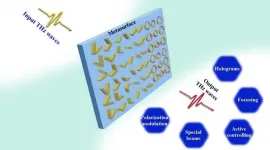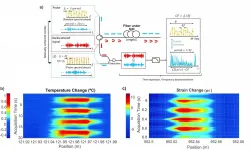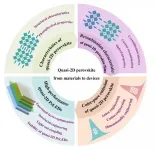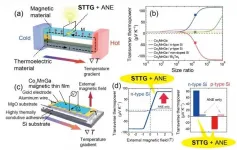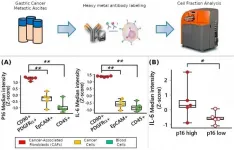INFORMATION:
Metasurfaces for manipulating terahertz waves
2021-03-23
(Press-News.org) THz waves have a plethora of applications ranging from biomedical and medical examinations, imaging, environment monitoring, to wireless communications, because of the abundant spectral information, low photon energy, strong penetrability, and shorter wavelength. THz waves with technological advances not only determined by the high-efficiency sources and detectors but also decided by a variety of the high-quality THz components/functional devices. However, traditional THz devices should be thick enough to realize the desired wave-manipulating functions, hindering the development of THz integrated systems and applications. Although metamaterials have been shown groundbreaking discoveries due to the tunable electric permittivity and magnetic permeability of a meta-atom, they are limited to technical challenges of fabrication and high loss of the metal-based unit cell.
In a new paper published in Light: Advanced Manufacturing, a team of scientists, led by Professor Songlin Zhuang from Terahertz Technology Innovation Research Institute, University of shanghai for Science and Technology, and co-workers have summarized the recent advancements of metasurfaces for the manipulation of THz waves. These ultra-compact devices with unusual functionalities render metasurface devices very attractive for applications such as imaging, encryption, information modulation and THz communications.
Actually, metasurfaces typically consist of planar antennas that enable predesigned EM responses. The antennas are made by metals or traditional high-refractive index dielectrics that can be easily fabricated based on the standard fabrication process. In addition, metasurfaces with the functionality in manipulating EM waves are dependent on the abrupt phase changes at planar antenna interfaces, and thus the thickness of metasurfaces is much thinner than the incident wavelength. Metasurfaces can locally control the wavefront of EM waves at subwavelength resolution, leading to various practical applications such as metalens, waveplates, vortex beam generators, beam steering and holograms. The ultrathin nature of metasurfaces, the ease of fabrication, and the subwavelength resolution in manipulating of EM waves make metasurfaces ideal candidates for THz device miniaturization (ultra-compact THz devices) and system integration.
The metasurface-based approach for manipulatig THz waves enables remarkable contributions in designing ultra-thin/ultra-compact and tunable THz components. The main advantages/contributions of THz metasurfaces can be concluded as follows: (1) THz components with reduced size: The functionalities of focusing, OAM, and polarization conversion realized by metasurfaces can be traditionally obtained by using a THz lens, helical phase plate, and half-wave (or quarter-wave) plate, respectively; (2) THz components with multiple functions: The traditional THz devices, e.g. THz lenses, waveplates, etc..., are always show a single function. Metasurfaces not only provide a flexible platform to realize ultra-thin/ultra-compact THz devices with single function, but also enable the unprecedented capability in designing multifunctional THz devices. (3) THz components with tunable function: Metasurfaces combined with VO2, graphene, etc, open a new avenue for designing THz components with active functions.
In conclusion, metasurfaces with planar structures can locally modify the wavefront of THz waves at subwavelength resolution. Metasurfaces not only provide an ultra-compact platform for manipulating the wavefront of THz waves, but also generate a plethora of applications that are difficult to achieve with conventional functional devices. As an overview, the recent developments of metasurfaces for manipulating THz waves were presented in this paper, and this progress report may open a new avenue to design ultra-thin or ultra-compact THz functional devices and systems.
ELSE PRESS RELEASES FROM THIS DATE:
A simple laser for quantum-like classical light
2021-03-23
Tailoring light is much like tailoring cloth, cutting and snipping to turn a bland fabric into one with some desired pattern. In the case of light, the tailoring is usually done in the spatial degrees of freedom, such as its amplitude and phase (the "pattern" of light), and its polarization, while the cutting and snipping might be control with spatial light modulators and the like. This burgeoning field is known as structured light, and is pushing the limits in what we can do with light, enabling us to see smaller, focus tighter, image with wider fields of view, probe with fewer photons, and to pack information ...
Time-expanded phase-sensitive optical time-domain reflectometry
2021-03-23
Distributed optical fiber sensing (DOFS) is currently a mature technology that allows "transforming" a conventional fiber optic into a continuous array of individual sensors, which are distributed along its length. Between the panoply of techniques developed in the field of DOFS, those based on phase-sensitive optical time-domain reflectometry (ΦOTDR) have gained a great deal of attention, mainly due to their ability to measure strain and temperature perturbations in real time. These unique features, along with other advantages of distributed sensors (reduced weight, electromagnetic immunity ...
High-performance quasi-2D perovskite light-emitting diodes: from materials to devices
2021-03-23
Light-emitting diodes (LEDs) are changing the lighting and display industry and have obtained significant advances than traditional lighting sources. The traditional materials LEDs, e.g., III-V semiconductor LEDs, organic LEDs (OLEDs) and quantum-dot LEDs (QLEDs), have achieved great success and gradually realized commercialization, but still face some challenges. The OLEDs have the low carrier transport capability and exciton recombination, which would hinder the improvement of brightness. Besides, QLEDs show challenges for the tedious manufacturing process and the reliance on hydrophobic insulating long ligands also hinders their stability and electrical conductivity.
Compared with these traditional materials, quasi-2D ...
Dementia death risk is higher among the socioeconomically deprived
2021-03-23
A large proportion of dementia deaths in England and Wales may be due to socioeconomic deprivation, according to new research led by Queen Mary University of London.
The team also found that socioeconomic deprivation was associated with younger age at death with dementia, and poorer access to accurate diagnosis.
Dementia is the leading cause of death in England and Wales, even during the COVID pandemic, and is the only disease in the top ten causes of death without effective treatment.
The research, published in the Journal of Alzheimer's Disease, examines Office for National Statistics mortality data for England and Wales, and finds that in 2017, 14,837 excess dementia deaths were attributable to deprivation, equating to 21.5 per cent of all dementia deaths ...
These baby great white sharks love to hang out near New York
2021-03-23
Uncovering detailed travel patterns and habitat use of sharks along and across shelf territories has been historically challenging - especially for most pelagic shark species - which remain offshore for most of their lives. Their vertical diving behavior has been a subject of inquiry for a long time, and for young sharks in particular, has remained elusive.
Using cutting-edge 3D satellite technology, a study led by Florida Atlantic University's Harbor Branch Oceanographic Institute, in collaboration with NOAA's National Marine Fisheries Service; OCEARCH; The South Fork Natural History Museum and Nature Center; and the Wildlife Conservation Society, is ...
Variances in critical protein may guide fate of those infected with SARS CoV-2
2021-03-23
Of the many perplexing questions surrounding SARS CoV-2, a mysterious new pathogen that has killed an estimated 2.6 million people worldwide, perhaps the most insistent is this: why does the illness seem to strike in such a haphazard way, sometimes sparing the 100 year old grandmother, while killing healthy young men and women in the prime of life?
A new study by Karen Anderson, Abhishek Singharoy and their colleagues at the Biodesign Institute at Arizona State University, may offer some tentative clues. Their research explores MHC-I, a critical protein component of the human adaptive immune system.
The research suggests that certain variant ...
Demonstration of unconventional transverse thermoelectric generation
2021-03-23
A NIMS research team devised a new thermoelectric generation mechanism with a hybrid structure composed of thermoelectric and magnetic materials. The team then actually fabricated this structure and observed the record-high thermopower appearing in the direction perpendicular to a temperature gradient (i.e., transverse thermoelectric generation). These results may offer insights into new mechanisms and structural designs applicable to the development of versatile energy harvesting technologies and highly sensitive heat flux sensors.
The Seebeck effect is a phenomenon in which a temperature gradient across a metal or semiconductor is converted into a thermoelectric voltage. Because this effect can be used to convert waste heat into electrical energy, its potential applications (e.g., ...
Aging cells in abdominal fluid cause increased peritoneal dissemination of gastric cancer
2021-03-23
Through an analysis of cellular components (cell fractions) from malignant ascites (fluid buildup in the abdomen caused by gastric cancer), a research collaboration based in Kumamoto University (Japan) has demonstrated that cellular senescence of cancer-associated fibroblasts (CAFs) play an important role in the peritoneal dissemination of gastric cancer foci (cells different from surrounding cells). This understanding should enable the development of new treatments for cancer dissemination in the peritoneum by targeting cancer cells at focal sites and CAFs in patients with gastric cancer.
Peritoneal dissemination ...
Short-lived plant species are more climate-sensitive
2021-03-23
Plant species with short generation times are more sensitive to climate change than those with long generation times. This is one of the findings of a synthesis study by researchers from the German Centre for Integrative Biodiversity Research (iDiv), the Martin Luther University Halle-Wittenberg (MLU) and the Helmholtz-Centre for Environmental Research (UFZ). The international team comprehensively compiled worldwide available data, mostly from Europe and North America, to address the question of how plant populations react to climate change. The study, published in Nature Communications, shows that plant characteristics such as generation ...
Association found between consumption of ultra-processed foods and drinks and colorectal cancer risk
2021-03-23
Consumption of ultra-processed foods and drink could increase the risk of developing colorectal cancer. This was the conclusion of a large study undertaken by the Barcelona Institute for Global Health (ISGlobal), a centre supported by the "la Caixa" Foundation, based on questionnaires about food behaviours completed by around 8,000 people in Spain. The study, the first of its kind in the country, also analysed the relationship between ultra-processed food and drink products and two other cancers; while no association was observed with prostate cancer, in the case of breast cancer a higher risk was observed in the sub-group of former and current smokers who reported a ...
